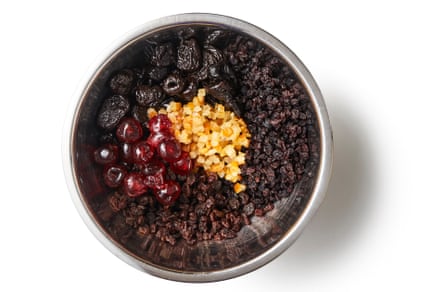Granting the Christmas wish of Trini-Irish reader Niall, for whom this cake is an essential part of the festive celebrations, this Caribbean classic is sure to convert even the most convinced fruitcake sceptic, not least because of the generous helping of rum. Each island has its own style, so this recipe is just a starting point: look up ones by Trinidad’s Shivi Ramoutar, Jamaica’s Brigid Ransome Washington and Barbados’ Paul Carmichael, among others, to see the difference.

Prep 40 min, plus soaking
Cook 5 hr
Makes 1 x 23cm cake
250g dried prunes
250g currants
100g dried or glacé cherries
100g raisins
75g candied citrus peel
400ml dark rum, plus extra for soaking
100ml cherry brandy liqueur (see step 2)
50g soft light brown sugar, or treacle, or browning sauce, to taste (see steps 3 and 7)
250g plain flour
½ tsp fine salt
2 tsp baking powder
1 tsp ground cinnamon
½ tsp ground nutmeg
¼ tsp ground allspice
250g butter, at room temperature
200g dark brown sugar
4 eggs
1 tsp vanilla extract
1 tsp almond essence
Grated zest of ½ lemon or lime
1 A note on the fruit

Jackie Christian, of Doreen’s Jamaican Homemade Rum Cakes, makes her black cake to her late mum’s recipe (it’s available online). She steeps her fruit for months, but rest assured that you can make a delicious, quicker version. Put the fruit in a large saucepan, swapping in different fruits as you like – Riaz Phillips, for instance, uses dates in his book West Winds.
2 Cover the fruit in booze

Add the alcohol. Christian swears by Wray & Nephew’s overproof white rum and Keshia Sakarah, chef/owner of Caribe’ in London, uses spiced rum, but dark rum seems the most popular choice. You could use rum alone, but most recipes add something sweeter and fruitier – such as cherry brandy liqueur (Ramoutar), port (Carmichael) or sweet sherry (chef and journalist Ramin Ganeshram). Though not at all traditional, the likes of sloe gin would work, too.
3 Steep the fruit

Bring the contents of the pan to a simmer, turn off, cover and leave to soak for as long as possible, and at least overnight. Black cake partly gets its colour from browning sauce (from specialist Caribbean food stores), but you can use treacle or make your own, as Melissa Thompson recommends in her book Motherland, by heating 50g soft light brown sugar to a deep, dark brown syrup, then stirring in 25ml hot water.
4 Blend the fruit

Once you’re ready to make the cake, put the fruit in a food processor or blender and whizz to a paste – as smooth or as chunky as you like (Christian’s is very smooth, but Ramoutar prefers hers a bit coarser). Line a deep, loose-bottomed 23cm cake tin with baking paper and heat the oven to 180C (160C fan)/350F/gas 4.
5 Start the cake batter

Put the flour, salt, baking powder and ground spices in a bowl, whisk to combine, then set aside. In another bowl, beat the butter in a stand mixer or with a handheld food mixer until soft, then beat the dark brown sugar until the mix is lighter in colour and voluminous. In another bowl, beat the eggs with the vanilla extract and almond essence.
6 Combine the eggs and butter

With the motor still running, gradually beat the egg mix into the butter mix, scraping down the sides of the bowl as required, so none of the butter and sugar gets left behind; add a spoonful of the flour mixture, if necessary, to stop it curdling (if it does curdle, it’s not the end of the world).
7 Add the flour mix and fruit

Fold in the dry ingredients with a large spoon, trying to keep as much air as possible in the mixture, then tip in the fruit puree, citrus zest and burnt sugar syrup/browning sauce. (Commercial browning sauces vary in strength, so start small and adjust until the batter is nice and dark, and taste regularly to make sure it isn’t overpowering the other ingredients.)
8 Bake the cake

Once the batter is evenly mixed, spoon it into the prepared tin and smooth the top. Bake for an hour, then turn down the heat to 160C (140C fan)/325F/gas 3 and bake for about four hours more, until a skewer or toothpick pushed into the centre comes out clean. Once cooked, poke holes all over the top of the cake and spoon over a little more rum.
9 Finishing touches
Leave the cake to cool completely in the tin, then wrap well in foil or paper – if storing, carry on brushing with rum occasionally, if you like. Ice as desired – royal icing is common, but it looks beautiful enough without. Unsurprisingly, this cake keeps very well for several months. Alternatively, eat it immediately.
Read Again https://news.google.com/rss/articles/CBMicGh0dHBzOi8vd3d3LnRoZWd1YXJkaWFuLmNvbS9mb29kLzIwMjMvZGVjLzE5L2hvdy10by1tYWtlLWNhcmliYmVhbi1ibGFjay1jYWtlLXJlY2lwZS1mZWxpY2l0eS1jbG9ha2UtbWFzdGVyY2xhc3PSAXBodHRwczovL2FtcC50aGVndWFyZGlhbi5jb20vZm9vZC8yMDIzL2RlYy8xOS9ob3ctdG8tbWFrZS1jYXJpYmJlYW4tYmxhY2stY2FrZS1yZWNpcGUtZmVsaWNpdHktY2xvYWtlLW1hc3RlcmNsYXNz?oc=5Bagikan Berita Ini














0 Response to "Alternative Christmas pudding: how to make Caribbean black cake – recipe - The Guardian"
Post a Comment